Readers are requested to note that in order to make the text intelligible in both hemispheres, plant flowering times etc are generally described in terms of seasons, not months. The following
table provides an approximate 'translation' of seasons into months for the two hemispheres.
Northern Southern
hemisphere hemisphere
Mid-winter January Mid-summer
Late winter February Late summer
Early spring March Early autumn
Mid-spring April Mid-autumn
Late spring May Late autumn
Early summer June Early winter
Mid-summer July Mid-winter
Late summer August Late winter
Early autumn September Early spring
Mid-autumn October Mid-spring
Late autumn November Late spring
Early winter December Early summer
MID-WINTER
Watering
As for early winter. See note below under 'General'.
Repotting
Do not repot.
Feeding
Do not feed.
Pruning
Do not prune.
Trimming
As for mid-autumn.
Root pruning
Do not root prune.
Insect pests
These should already have been eliminated.
Wiring
Leave it alone.
Propagation
Cuttings. For seeds, see mid-autumn.
General
Inspect periodically, especially when snow may start to fall. The greatest danger is drought due
to a snow-covered pot drying out. Perhaps the best antidote is to put the pot in the bath and spray with cold water until the snow is dis-persed. The temperature should be kept low, but
the water will get to the soil eventually. Keep in a cool room or put outside during the day in sunshine if possible. If you have ordered loam, peat and other supplies, start getting them ready.
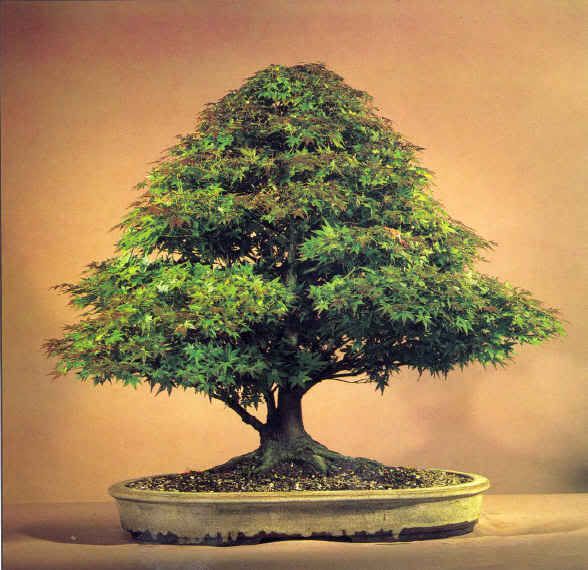
FORMAL STYLE JAPANESE MAPLE
(Acer palmatum 'Kash i ma')
This 27 inch tall dwarf variety of Japanese
maple was imported in 1981 and was said
to be 35 years old at that time. Its unusual lower branch structure and its massive
33 inch spread make this a very desirable specimen.
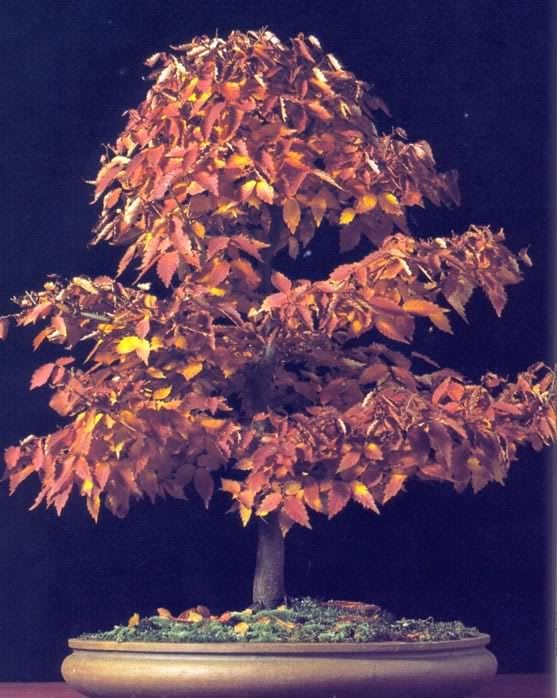
INFORMAL UPRIGHT JAPANESE HORNBEAM
(Carpinus laxiflora)
This 18 inch tall tree is surprisingly well
proportioned for its 15 years. The delicate foliage turns yellow, then golden brown in
autumn, and remains on the tree all winter.
LATE WINTER
Watering
In dry weather, twice a week. In wet weather, let the rain do it for you, but give water if it has not rained for three days. Water in the morning.
Repotting
No repotting this month. Make sure you have plenty of dry sifted soil ingredients or compost ready for the spring, and store under cover. If you have not already done so, make a list of the
trees you intend to re-pot. To decide if this is needed, turn the root ball out of its container
carefully and examine it; if it is a tight network of roots then it needs root pruning and repotting.
This is done to keep the roots active and growing in fresh new soil. Check that you have all reserve pots cleaned ready for potting on.
Feeding
Hardly necessary yet. For trees that are not to be repotted, but where plenty of future growth is desired, a little bone meal can be given.
Pruning
It is not advisable to remove unwanted branches or twigs yet. Those that you remove may be
alive, those that you leave may turn out to be dead.
Trimming
None is necessary yet.
Root pruning
Not yet.
Insect pests
Still too early to worry, except for citrus, which may have brown scale insects still undetected. Pick these off by hand.
Wiring
Not yet.
Propagation
Prepare seedpans for sowing. Soak slow-starting seeds and sow under glass. A good month to
start striking willow cuttings.
General
In cold weather keep tender plants in an unheated room. Water them once a week. Check all pots for cracks or frost damage and trees for gale damage, and add casualties to repotting list. Check condition of tools, sieves, syringe and other apparatus. Watch for movement in early flowering trees such as chaenomeles, forsythia, winter jasmine.
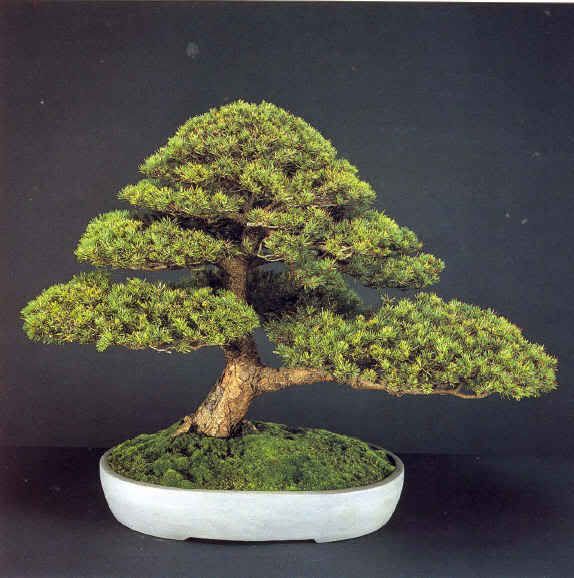
INFORMAL UPRIGHT SCOTS
PINE
(Pin us sylvestris var. beuvronensis) In 1974 this tree was bought from a nursery as an eight year old garden plant. Its naturally dwarf habit and tight foliage make it an ideal variety for bonsai. It took only 14 years to produce this 32 inch tall, very mature looking specimen, which could compete on equal terms with any Japanese white pine.

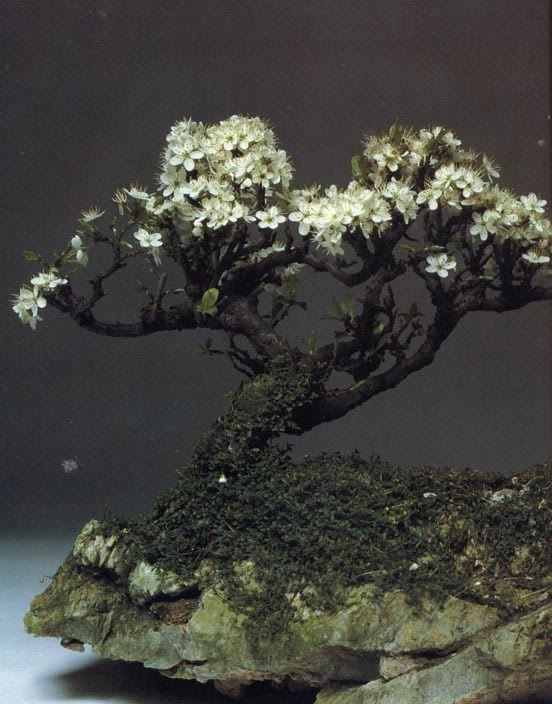
DRIFTWOOD STYLE SLOE (Prunus spinosa)
This tree was considerably larger than its current 14 inches when it was originally collected from a condemned hedgerow, but it was drastically pruned to a limbless trunk and all the branches were grown on
from scratch. The striking shari (exposed heartwood) was created later. This free-flowering species is uncommon as a bonsai, a fact which does not do it justice. 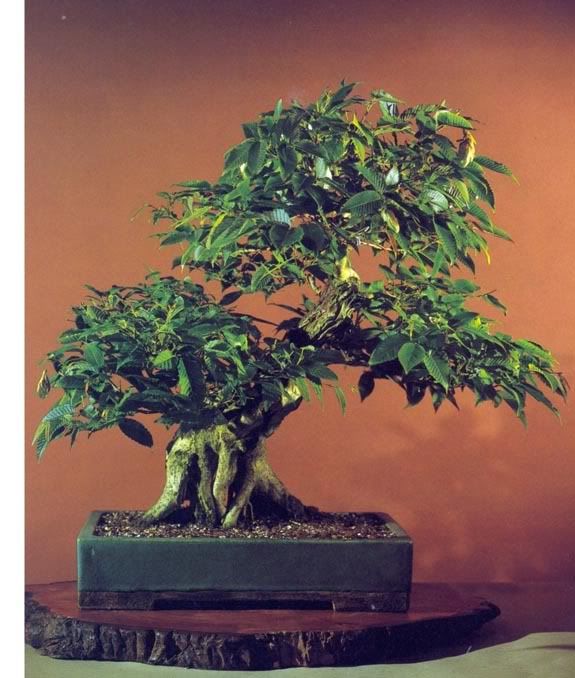
TWIN TRUNK JAPANESE HORNBEAM
(Carpinus laxiflora)
Originally this tree had three trunks, but after importing it in 1975 Peter Adams removed the central one and converted the design to a more pleasing and betterbalanced twin trunk. The scar, where the middle trunk used to be, has been hollowed out over the years and is now an integral part of the tree, adding character and age. At 55 years old, this tree is now 28 inches tall.
EARLY SPRING
Watering
As for late winter, spray any repotted trees daily.
Repotting
Have you followed the late winter instruction? Make sure now and remedy deficiencies. Watch
the buds of trees listed for repotting. Mild weather may bring them on. As soon as they start to move, repot quickly, and shelter them from wind. Cold weather later in the month may be drying and cause checks. Root prune when you are repotting.
Feeding
As for late winter. Do not feed newly repotted trees.
Pruning
Unwanted branches may be removed only if the retained branches are clearly alive with buds on the move. But exercise restraint. Prune back to a suitable live bud pointing in the right direction.
Seal large wounds with a sealing compound.
Trimming
Where too much growth is expected, and buds are well advanced, removal of unwanted future twigs may be anticipated by pinching out buds now. Where bushiness is desired, terminal buds may be pinched out if they are adequately sup-ported by numerous lower buds. But do not overdo pinching.
Root pruning
See above under 'Repotting'.
Insect pests
Still too early, but see late winter note.
Wiring
Not yet. Remove any existing wire that might cut into the bark.
Propagation
Sow any seeds you left out last month. Suggestions for early spring sowing are Maule's dwarf quince, cedar, pine, crab, punica granatum nana, cypress, sophora japonica. Take softwood cuttings when buds are well on the move.
General
Check stock of insecticides, fertilisers, wire. Inspect unopened buds for signs of opening. Wash down all storage shelves and benches and outside of all pots. Glazed pots of Japanese ori-gin can be cleaned by rubbing down with scour-ing powder, or if dirt is extremely hard to dislodge, with steel wool. Examine apparently dead trees, but do not discard such casualties yet. Add new top soil where required to trees not being repotted. Many may require this after winter rains. In others the top soil may look sour; remove this and replace with fresh compost.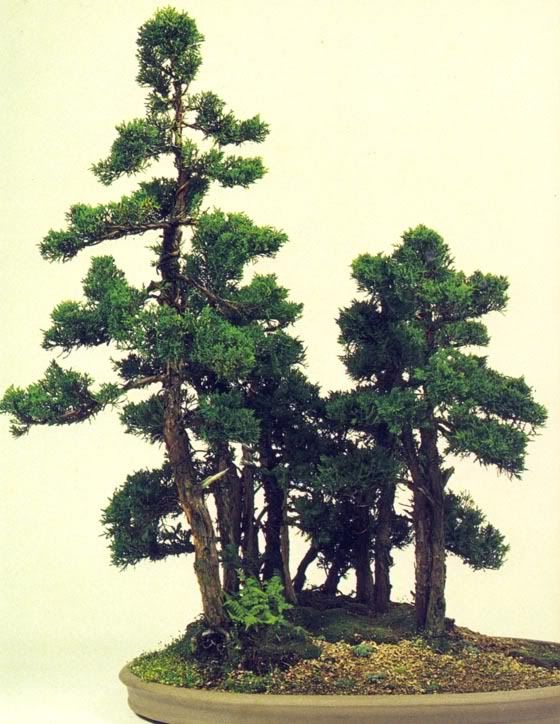
GROUP STYLE BLAAUW'S
JUNIPER
(Juniperus x media 'Blaauw')
Composed of trees ranging from ten to 20 years old, this group was styled by John Naka of California using commercial nursery stock. The tallest tree in the group is 32 inches high.
MID-SPRING
Watering
Give water once a day if it does not rain, sparingly for older trees, more for young trees where growth is wanted. Spray repotted trees daily.
Repotting
Complete all repotting.
Feeding
Do not feed trees repotted this month. Feed sparingly any trees repotted more than two weeks ago. Feed flowering trees which have not been repotted. Others may have bone meal mixed with a little wood ash and dried blood.
Pruning
As for early spring, but you can be bolder if the buds are breaking.
Trimming
As for early spring, but pinching can be resorted to more boldly.
Root pruning
Root prune as necessary all trees being repotted.Trees not being repotted can be lifted out and roots inspected, but do not prune if they show healthy new white ends and are not becoming root-bound.Trim off any roots that have grown out through the drainage holes.
Insect pests
Watch for red spider and white scale. Spray with insecticide at appropriate strength.
Wiring
Not yet. Have you removed all dangerous exist-ing wiring? (See early spring note.)
Propagation
Take cuttings of late starters. Pot on last year's seedlings.
General
Remove weeds. Plant moss. Inspect unopened buds for signs of opening. Be ready to give protection against night frosts to trees with newly-opened leaves. Consider discarding winter casualties. If flowering bonsai are brought indoors for display, they should be kept away from any source of heat and should not be kept
indoors for more than a couple of days at a time.

INFORMAL STYLE ENGLISH OAK (Quercus robur)
This unique oak tree was first dug up from a garden in 1957, when it was estimated to be 20 years old. It was immediately planted in a half barrel, whore it remained undisturbed until 1980, at which point its creator, Harry Tomlinson, persuaded the owner to part with it. After only six years training it was exhibited at the national exhibition in Osaka, Japan, where it won a first prize. It is unquestionably the finest example of a bonsai oak in existence.

INFORMAL UPRIGHT RED
MAPLE
(Acerpalmatum'Beni Seigai')
This incredibly beautiful 34 inch tall tree was imported from Japan in 1976 and is now over 100 years old. The transition of the foliage colour from pink in spring, through delicate greens to vivid red in autumn is in itself enough to make this tree the star of any collection.
LATE SPRING
Watering
As for mid-spring. On warm days water twice daily any tree whose growth is to be encouraged. Spray repotted trees daily.
Repotting
It is really almost too late to re-pot, so do it early and do it quickly if you must.
Feeding
Solids can be given every ten days if growth is to be encouraged. A little liquid feed diluted to half strength can also be added to the water once a week. Generous feeding for flowering trees, and for deciduous trees that have been leaf-cut.
Pruning
Young trees under training - remove any remaining unwanted branches. Older trees - check that the wounds where any branches have been removed are carved and shaped to permit the callus to grow over them.
Trimming
Keep a constant check to pinch unwanted buds and new shoots. Leaf-cut deciduous trees if you wish to increase twigginess, provided the leaves have become 'leather-hard'.
Root pruning
See mid-spring note for trees that have not been repotted.
Insect pests
Watch for red spider, aphids, ants, mealy bugs. Spray. Cut off infected leaves of deciduous trees
and burn them.
Wiring
Start on the larger branches.
Propagation
Conifer cuttings.
General
Remove weeds. Put sun-sensitive trees such as elms and zelkovas into half shade, but still be
ready with frost protection (see mid-spring note) for newly opened trees. Inspect unopened buds for signs of opening.

INFORMAL STYLE TRIDENT MAPLE
(Acer buergerianum)
This massive 34 inch tall tree was imported in 1968 at a reputed age of 90 years. The gentle curve of the trunk and well separated foliage masses create an elegance which is unusual in this species.
EARLY SUMMER
Watering
Water morning and evening every day in dry weather.
Repotting
Too late for potting in new soil, which would disturb roots, but you can pot on if you are careful to leave the old soil ball undisturbed.
Feeding
As for late spring.
Pruning
As for late spring.
Trimming
As for late spring. Check daily if possible.
Root pruning
Avoid this.
Insect pests
As for late spring. Try to check every day.
Wiring
Wire smaller branches.
Propagation
If this season's seedlings are thriving, pot on into small training pots.
General
Remove weeds, especially liverwort if it is ram-pant. Keep sun-sensitive trees in half shade.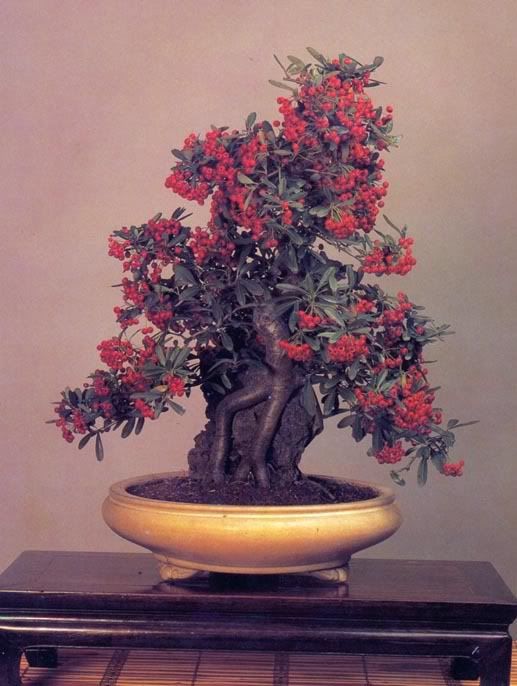
ROOT-OVER-ROCK STYLE PYRACANTNA
(Pyracantha angustifolia)
Including the rock, this gorgeous tree stands 24 inches tall and was produced in 35 years. Pyracantha is not only acommon garden shrub, but also makesspectacular bonsai. Tiny white flowers in early summer are followed by brilliant red or orange berries which persist on the plant all winter. This photograph was taken in early spring when there was still enough fruit to weigh down the branches.
MID-SUMMER
Watering
Water and spray foliage morning and evening every day, except when appreciable rain has
fallen. Avoid watering in direct sunlight if possible. Be generous to trees planted in shallow pots, trees with a lot of moss in their pots, and trees subject to drying wind.
Repotting
Do not re-pot. If a pot is broken or the soil is par-tially washed out by heavy rain, or disturbed by animals or accidents, pack the soil ball into a new pot without disturbing the roots.
Feeding
Give occasional feeds. Little and often is better than large amounts. Feed more generously trees undergoing heavy trimming or leaf-cutting.
Pruning
Pruning can still be carried out.
Trimming
Growth is still fairly rapid in many trees. Maple, zelkova, elm, must be constantly trimmed.
Spruce and juniper may still need their new needles shortened by pinching. Check each tree daily if possible. Remove dead brown needles from conifers.
Root pruning
Avoid this.
Insect pests
Try to check every day. Cut off infected leaves. Spray.
Wiring
Do not wire.
Propagation
Cuttings can always be taken.
General
Remove weeds, especially liverwort. Keep sunsensitive trees in half shade - maple, elm,
japonica and any that show signs of leaf scorch.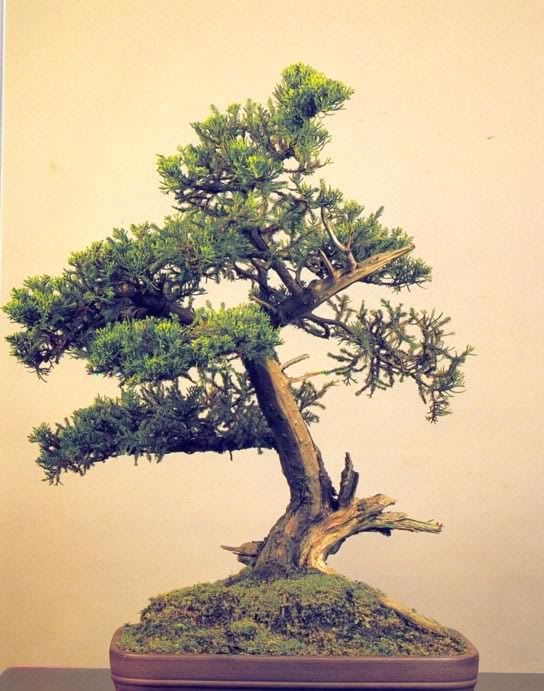
DRIFTWOOD STYLE JUNIPER
(Juniperus chinensis `San Jose') Originally grown as an ornamental garden plant, this tree was excavated in 1982 when it had grown to a spread of eight feet. After allowing it to live in a largeflower pot for a few years, to establish a new root system, it was pruned and styled. The prominent driftwood areas reveal where the major branches were removed, but skilful shaping simulates the ravages of a harsh climate and immediately gives the tree an ancient appearance.
LATE SUMMER
Watering
As for mid-summer.
Repotting
As for mid-summer.
Feeding
Begin to taper off the feeding. Stop solids but continue with a little liquid feed in the watering.
Pruning
Avoid pruning if possible.
Trimming
Little is now needed, as growth will have slowed down. Remove dead brown needles from conifers.
Root pruning
Avoid this, except for fast root-growers, such as willow, cherry, chestnut, ash. Lift the soil ball out of the pot and examine, but do not prune unless the bottom surface is a solid mat of roots.
Insect pests
As for mid-summer.
Wiring
Do not wire.
Propagation
Take semi-hardwood cuttings for rooting under glass. This is a good month for any cuttings.
General
Keep down weeds. Sun-sensitive trees still need protection.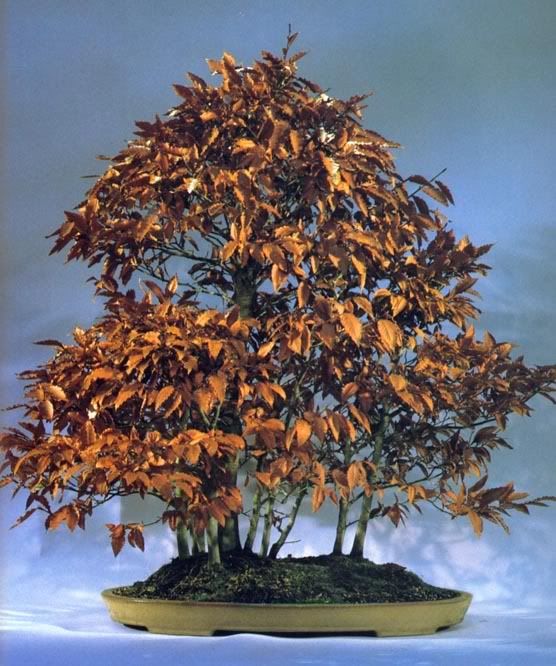
GROUP STYLE JAPANESE BEECH
(Fagus crenata)
At 36 inches high this group is tallerthan it seems in the photograph. The most attractive features of this species include the strikingly white bark on older trunks and the fact that it tends to retain its
copper-coloured leaves all winter.
EARLY AUTUMN
Watering
Water at least once a day in dry weather.
Repotting
Those who favour autumn repotting for conifers could start late in the month.
Feeding
Feed very sparingly.
Pruning
Do not prune.
Trimming
There may be a pre-autumn burst of growth requiring light trimming.
Root pruning
Do not root prune.
Insect pests
As for mid-summer.
Wiring
Do not wire. Test wired branches gingerly to see if they have taken the required permanent set. If so, remove wire. Do not bend or rewire.
Propagation
Take semi-hardwood and hardwood cuttings.
General
Remove weeds and any moss not in top condi-tion. Protect moss from birds, which at this time are searching for insects. Remove dead leaves and tidy up the pots. By now you may have
found some wild trees for lifting. When possible, leave them for lifting next spring, but if this is not practicable, lift them now.
MID-AUTUMN
Watering
Water only in dry spells but check frequently. RepottingSee early autumn note on repotting
Repotting
See early autumn note on repotting.
Feeding
Do not feed.
Pruning
Do not prune.
Trimming
Deciduous trees probably have no leaves to trim. Conifers should not be trimmed.
Root pruning
Do not root prune.
Insect pests
As for mid-summer, but there will not be many pests still active.
Wiring
As for early autumn.
Propagation
Cuttings as for early autumn. Plan your seed sowing programme. Probably the best overall
results are obtained by gathering fresh seeds now and sowing for germination next spring.
Hard coated seeds such as hawthorn may require up to 18 months stratification. If you have
enough, divide seed into two batches, one for immediate sowing, the other for stratification.
General
As for early autumn. If you contemplate plunging any pots, get the ground ready now. If you are going to winter any pots inside, get suit-able space cleared for them in a cool room. Most trees can stay outside but tender or exotic ones may need protection, as may conifers that would
offer lodgment for snow.
LATE AUTUMN
Watering
Water sparingly.
Repotting
Do not re-pot.
Feeding
Do not feed.
Pruning
Do not prune.
Trimming
As for mid-autumn.
Root pruning
Do not root prune.
Insect pests
Check over all branches and twigs, and pick off any galls, blisters, scale insects and other infesta-
tions that may think they are settled in their winter quarters. Water thoroughly all trees, soil
and pots with a mild disinfectant fungicide. Wiring As for early autumn.
Propagation
Cuttings. You can pot on last spring's seedlings if you do not disturb the root ball. This will save time next spring, when you are bound to be busy.
General
Review the trees that are to be given shelter citrus, azaleas, conifers with spreading branches.
Plunge or protect with straw. Gravel or cinders can be used to plunge the pots in. Check all pots
to ensure that drainage holes are clear. Frosts are more dangerous to pots than to trees.
BROOM STYLE JAPANESE MAPLE
(Acer palmatum `Kashima )
The leaves on this dwarf variety of maple are among the earliest to emerge in spring. This photograph was taken in late winter and already the buds have burst and the young, bronze coloured foliage is
beginning to show. Imported in 1986 by Peter Chan, it is said to be 65 years old and stands 20 inches high with a spread of 26 inches.
EARLY WINTER
Watering
Water only when necessary, keeping compost slightly on the dry side. Water in the morning,
not the evening. It is inadvisable to have the pot full of water when the night temperature drop
occurs.
Repotting
Do not re-pot.
Feeding
Do not feed.
Pruning
Do not prune.
Trimming
Do not trim.
Root pruning
Do not root prune.
Insect pests
As for late autumn if you have the energy.
Wiring
Leave it alone.
Propagation
Cuttings. For seeds, see mid-autumn.
General
Inspect periodically. If a pot is cracked, tie it up with string or the like as a temporary measure. It is not too early to check your supplies and order as necessary.
Please look info to.....Previous TRAINING AND MAINTENANCE......next first Page BONSAI TREES and How Growing Bonsai Trees




No comments:
Post a Comment